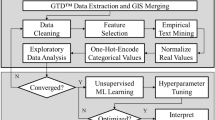Abstract
Topographic maps are an appealing exploratory instrument for discovering new knowledge from databases. During the recent years, several variations on the Self Organizing Maps (SOM) were introduced in the literature. In this paper, the toroidal Emergent SOM tool and the spherical SOM are used to analyze a text corpus consisting of police reports of all violent incidents that occurred during the first quarter of 2006 in the police region Amsterdam-Amstelland (The Netherlands). It is demonstrated that spherical topographic maps provide a powerful instrument for analyzing this dataset. In addition, the performance of the toroidal Emergent SOM is compared to that of the spherical SOM, and it turned out to be superior to that of an ordinary classifier, applied directly to the data.
Preview
Unable to display preview. Download preview PDF.
Similar content being viewed by others
References
Keus, R., Kruijff, M.S.: Huiselijk geweld, draaiboek voor de aanpak. Directie Preventie, Jeugd en Sanctiebeleid van de Nederlandse justitie (2000)
Watts, C., Timmerman, C.: Violence against women: global scope and magnitude. The Lancet 359(9313), 1232–1237 (RMID 1155557)
Waits, K.: The criminal Justice System’s response to Battering: Understanding the problem, forging the solutions. Washington Law Review 60, 267–330 (1984-1985)
Minleer-Black, C.: Domestic violence: Findings from a new British Crime Survey self-completion questionnaire. Home Office Research Study, London (1999)
Vincent, J.P., Jouriles, E.N.: Domestic violence. Guidelines for research-informed practice. Jessica Kingsley Publishers, London (2000)
Ritter, H.: Non-Euclidean Self-Organizing Maps, pp. 97–109. Elsevier, Amsterdam (1999)
Kohonen, T.: Self-Organized formation of topologically correct feature maps. Biological Cybernetics 43, 59–69 (1982)
Ultsch, A., Moerchen, F.: ESOM-Maps: Tools for clustering, visualization, and classification with Emergent SOM. Technical Report Dept. of Mathematics and Computer Science, University of Marburg, Germany, No. 46 (2005)
Ultsch, A., Hermann, L.: Architecture of emergent self-organizing maps to reduce projection errors. In: Proc. ESANN 2005, pp. 1–6 (2005)
Ultsch, A.: Density Estimation and Visualization for Data containing Clusters of unknown Structure. In: Proc. GfKI 2004 Dortmund, pp. 232–239 (2004)
Ultsch, A.: Maps for visualization of high-dimensional Data Spaces. In: Proc. WSOM 2003, Kyushu, Japan, pp. 225–230 (2003)
Ultsch, A., Siemon, H.P.: Kohonen’s Self Organizing Feature Maps for Exploratory Data Analysis. In: Proc. Intl. Neural Networks Conf., pp. 305–308 (1990)
Tokutaka, H., BLOSSOM Software Tool, http://www.somj.com
Nakatsuka, D., Oyabu, M.: Application of Spherical SOM in Clustering. In: Proc. Workshop on Self-Organizing Maps (WSOM 2003), pp. 203–207 (2003)
Van Hulle, M.: Faithful Representations and Topographic Maps from distortion based to information based Self-Organization. Wiley, New York (2000)
Peng, H., Long, F., Ding, C.: Feature Selection Based on Mutual Information: Criteria of Max-Dependency, Max-Relevance, and Min-Redundancy. IEEE Transactions on pattern analysis and machine intelligence 27(8) (2005)
Author information
Authors and Affiliations
Editor information
Editors and Affiliations
Rights and permissions
Copyright information
© 2009 Springer-Verlag Berlin Heidelberg
About this paper
Cite this paper
Poelmans, J., Elzinga, P., Viaene, S., Dedene, G., Van Hulle, M.M. (2009). Analyzing Domestic Violence with Topographic Maps: A Comparative Study. In: Príncipe, J.C., Miikkulainen, R. (eds) Advances in Self-Organizing Maps. WSOM 2009. Lecture Notes in Computer Science, vol 5629. Springer, Berlin, Heidelberg. https://doi.org/10.1007/978-3-642-02397-2_28
Download citation
DOI: https://doi.org/10.1007/978-3-642-02397-2_28
Publisher Name: Springer, Berlin, Heidelberg
Print ISBN: 978-3-642-02396-5
Online ISBN: 978-3-642-02397-2
eBook Packages: Computer ScienceComputer Science (R0)




